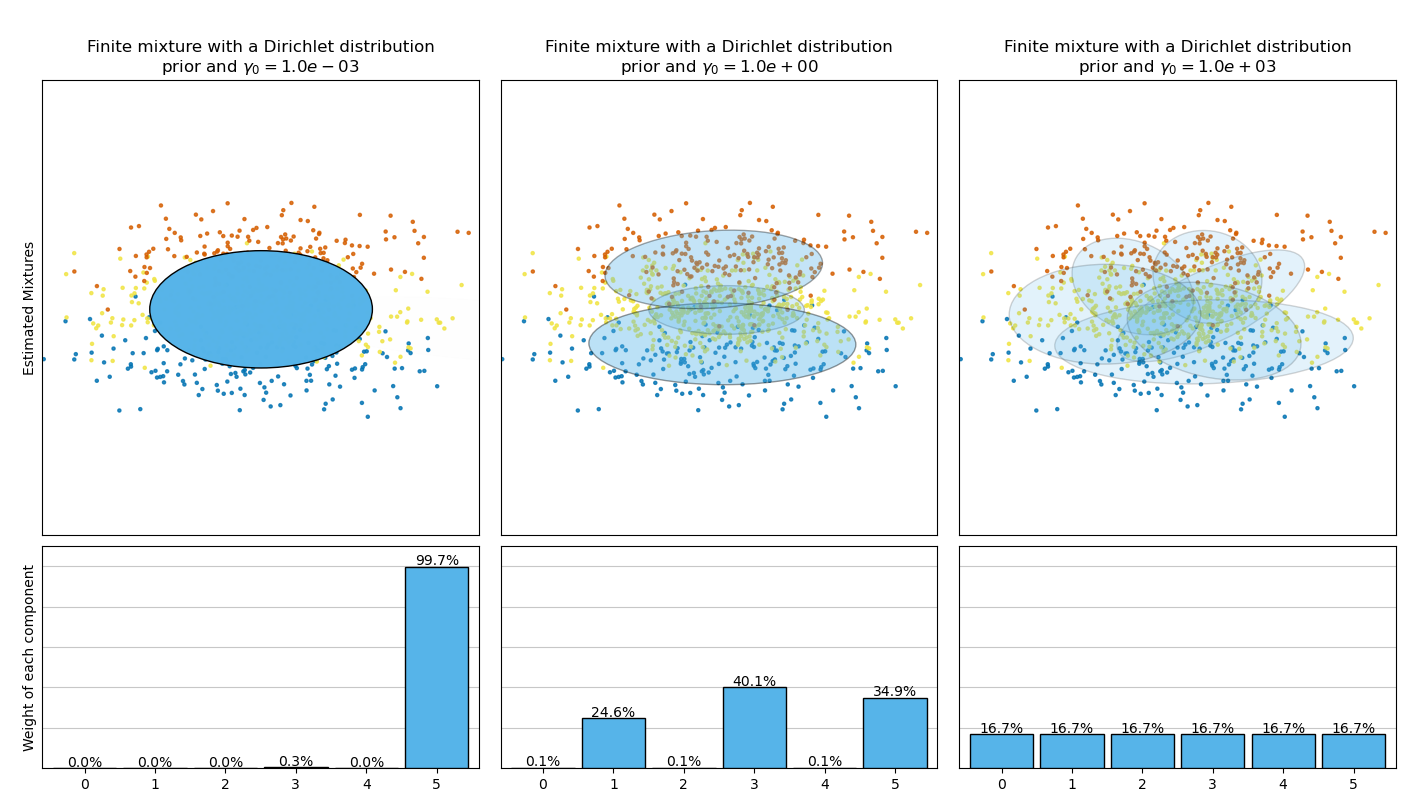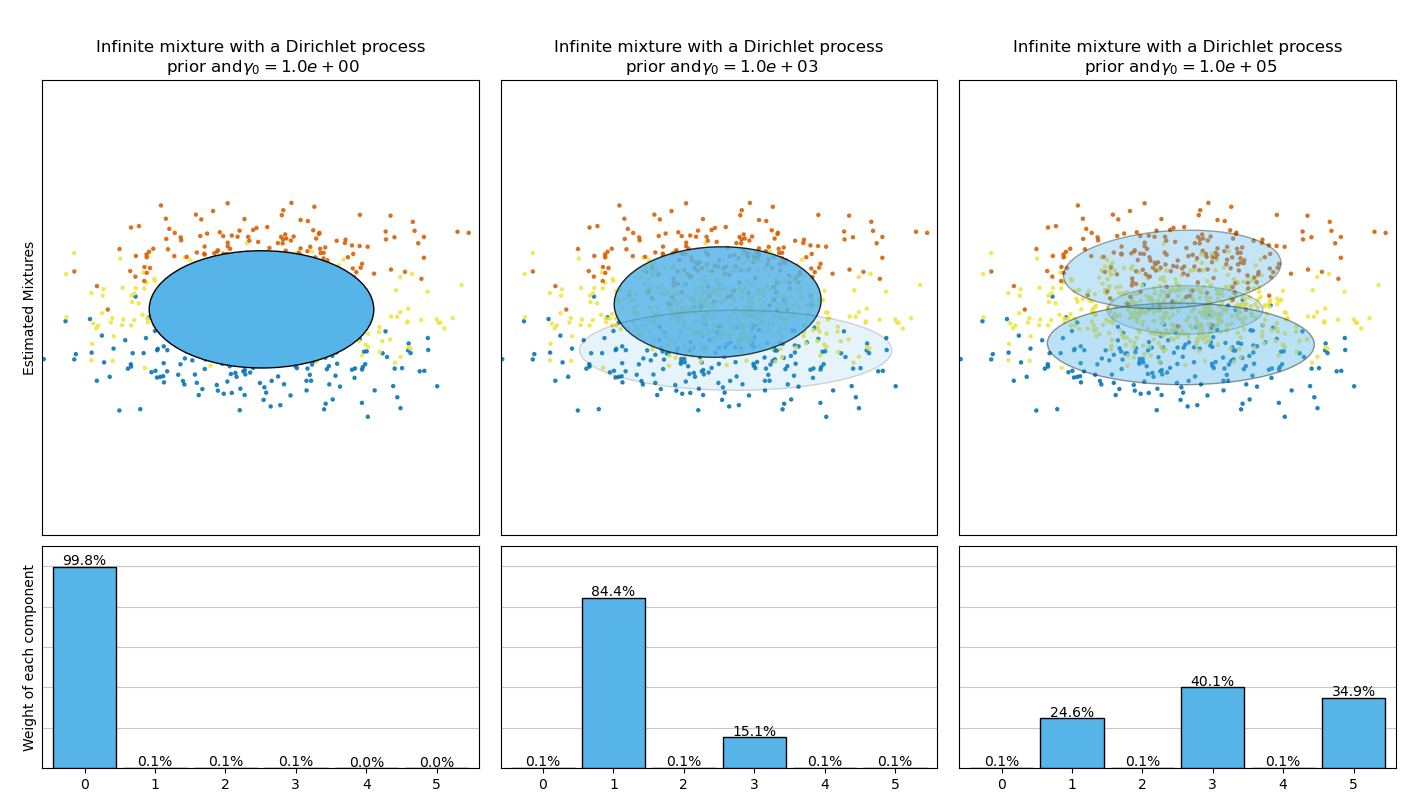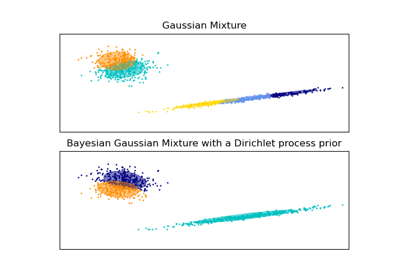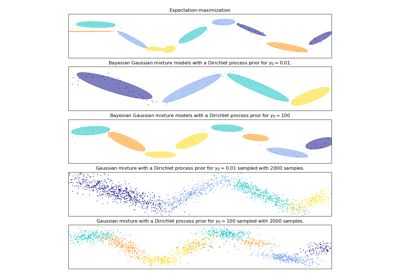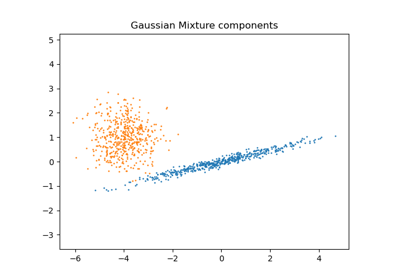注意
跳转至末尾以下载完整示例代码,或通过 JupyterLite 或 Binder 在浏览器中运行此示例
变分贝叶斯高斯混合的集中先验类型分析#
本示例绘制了通过 BayesianGaussianMixture 类模型(使用狄利克雷分布先验(weight_concentration_prior_type='dirichlet_distribution')和狄利克雷过程先验(weight_concentration_prior_type='dirichlet_process'))拟合玩具数据集(三个高斯混合)得到的椭球。在每个图中,我们绘制了权重集中度先验的三个不同值的结果。
BayesianGaussianMixture 类可以自动调整其混合组件的数量。参数 weight_concentration_prior 与非零权重的组件数量有直接关系。为集中度先验指定一个较低的值将使模型将大部分权重放在少数组件上,并使剩余组件的权重非常接近零。集中度先验的较高值将允许更多组件在混合中活跃。
狄利克雷过程先验允许定义无限数量的组件,并自动选择正确的组件数量:它只在必要时激活组件。
相反,带有狄利克雷分布先验的经典有限混合模型将倾向于更均匀加权的组件,因此往往会将自然聚类划分为不必要的子组件。
# Authors: The scikit-learn developers
# SPDX-License-Identifier: BSD-3-Clause
import matplotlib as mpl
import matplotlib.gridspec as gridspec
import matplotlib.pyplot as plt
import numpy as np
from sklearn.mixture import BayesianGaussianMixture
def plot_ellipses(ax, weights, means, covars):
for n in range(means.shape[0]):
eig_vals, eig_vecs = np.linalg.eigh(covars[n])
unit_eig_vec = eig_vecs[0] / np.linalg.norm(eig_vecs[0])
angle = np.arctan2(unit_eig_vec[1], unit_eig_vec[0])
# Ellipse needs degrees
angle = 180 * angle / np.pi
# eigenvector normalization
eig_vals = 2 * np.sqrt(2) * np.sqrt(eig_vals)
ell = mpl.patches.Ellipse(
means[n], eig_vals[0], eig_vals[1], angle=180 + angle, edgecolor="black"
)
ell.set_clip_box(ax.bbox)
ell.set_alpha(weights[n])
ell.set_facecolor("#56B4E9")
ax.add_artist(ell)
def plot_results(ax1, ax2, estimator, X, y, title, plot_title=False):
ax1.set_title(title)
ax1.scatter(X[:, 0], X[:, 1], s=5, marker="o", color=colors[y], alpha=0.8)
ax1.set_xlim(-2.0, 2.0)
ax1.set_ylim(-3.0, 3.0)
ax1.set_xticks(())
ax1.set_yticks(())
plot_ellipses(ax1, estimator.weights_, estimator.means_, estimator.covariances_)
ax2.get_xaxis().set_tick_params(direction="out")
ax2.yaxis.grid(True, alpha=0.7)
for k, w in enumerate(estimator.weights_):
ax2.bar(
k,
w,
width=0.9,
color="#56B4E9",
zorder=3,
align="center",
edgecolor="black",
)
ax2.text(k, w + 0.007, "%.1f%%" % (w * 100.0), horizontalalignment="center")
ax2.set_xlim(-0.6, 2 * n_components - 0.4)
ax2.set_ylim(0.0, 1.1)
ax2.tick_params(axis="y", which="both", left=False, right=False, labelleft=False)
ax2.tick_params(axis="x", which="both", top=False)
if plot_title:
ax1.set_ylabel("Estimated Mixtures")
ax2.set_ylabel("Weight of each component")
# Parameters of the dataset
random_state, n_components, n_features = 2, 3, 2
colors = np.array(["#0072B2", "#F0E442", "#D55E00"])
covars = np.array(
[[[0.7, 0.0], [0.0, 0.1]], [[0.5, 0.0], [0.0, 0.1]], [[0.5, 0.0], [0.0, 0.1]]]
)
samples = np.array([200, 500, 200])
means = np.array([[0.0, -0.70], [0.0, 0.0], [0.0, 0.70]])
# mean_precision_prior= 0.8 to minimize the influence of the prior
estimators = [
(
"Finite mixture with a Dirichlet distribution\n" r"prior and $\gamma_0=$",
BayesianGaussianMixture(
weight_concentration_prior_type="dirichlet_distribution",
n_components=2 * n_components,
reg_covar=0,
init_params="random",
max_iter=1500,
mean_precision_prior=0.8,
random_state=random_state,
),
[0.001, 1, 1000],
),
(
"Infinite mixture with a Dirichlet process\n" r"prior and $\gamma_0=$",
BayesianGaussianMixture(
weight_concentration_prior_type="dirichlet_process",
n_components=2 * n_components,
reg_covar=0,
init_params="random",
max_iter=1500,
mean_precision_prior=0.8,
random_state=random_state,
),
[1, 1000, 100000],
),
]
# Generate data
rng = np.random.RandomState(random_state)
X = np.vstack(
[
rng.multivariate_normal(means[j], covars[j], samples[j])
for j in range(n_components)
]
)
y = np.concatenate([np.full(samples[j], j, dtype=int) for j in range(n_components)])
# Plot results in two different figures
for title, estimator, concentrations_prior in estimators:
plt.figure(figsize=(4.7 * 3, 8))
plt.subplots_adjust(
bottom=0.04, top=0.90, hspace=0.05, wspace=0.05, left=0.03, right=0.99
)
gs = gridspec.GridSpec(3, len(concentrations_prior))
for k, concentration in enumerate(concentrations_prior):
estimator.weight_concentration_prior = concentration
estimator.fit(X)
plot_results(
plt.subplot(gs[0:2, k]),
plt.subplot(gs[2, k]),
estimator,
X,
y,
r"%s$%.1e$" % (title, concentration),
plot_title=k == 0,
)
plt.show()
脚本总运行时间: (0 分 6.602 秒)
相关示例

